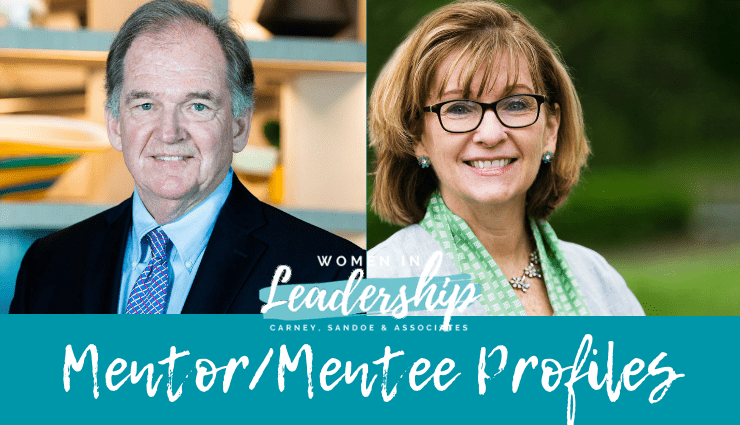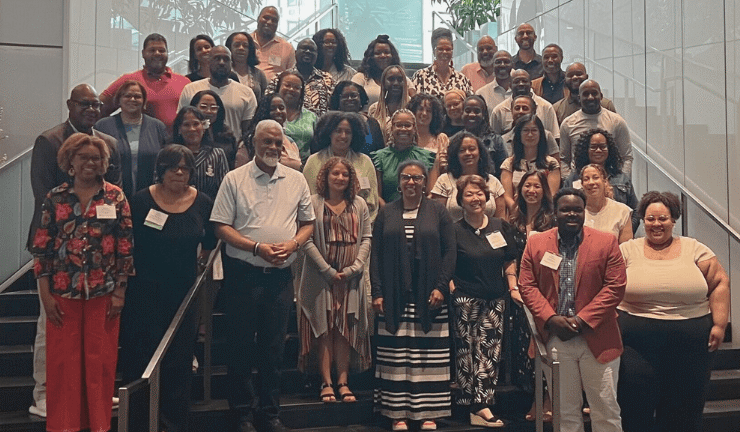Mentor/Mentee Profile: A Partnership for Institution Building

This spring, CS&A is shining a spotlight on women in leadership. This piece is one of a series of stories about female leaders in independent schools, the importance of mentorship, and their professional journeys. Find the full series here.
CS&A is proud to have hosted the third-annual Women’s Institute on June 14 in Boston, an event designed to support women and their allies in the education community. Our Placement and Search Groups are dedicated to increasing the number of women in leadership roles as part of our commitment to diversity, equity, and inclusion.
Find the joy in learning. Find the joy in teaching.
Help students build a strong academic base, engage them in their interests, and encourage curiosity and academic risk-taking.
Help teachers develop and improve their teaching skills. Offer the rising stars the chance to lead.
In this way, you build a better school — to help build a better world.
This is the philosophy that Bill Christ, now a consultant with Carney, Sandoe & Associates, brought to his first and only headship, a 29-year stint at Hathaway Brown School, an all-girls, K-12 school in Shaker Heights, Ohio.
It is also the philosophy shared by one of his first hires, a young teacher named Sue Sadler, who he’d mentor and support through her decades-long stay at Hathaway Brown straight into her own first headship at The Bryn Mawr School, an all-girls school in Baltimore.
Over the time that Bill and Sue worked together at Hathaway Brown, they would increase enrollment from 480 to 900 girls and build the school’s reputation from a well-regarded regional school into one of national and even international note — designed for and around the needs of girls but serving as a cutting-edge, innovative education model for all schools.
Although Bill would serve as a mentor for Sue during these years, he tends to describe the relationship more as a professional partnership in which they would both learn and grow together. Looking back, Bill says he saw it as an essential aspect of his job to offer Sue (and other educators at the school) the opportunity to develop into their highest capacity as educators. In an all-girls school, this was particularly important with women educators.
“For one thing, I don’t want anyone to ever feel they are boxed in at the school,” Bill says. “At the same time, encouraging educators to step up is the surest path for the school’s success.”
Bill and Sue would stay at Hathaway Brown for so many years, they both say, because they never felt boxed in. Every year brought new challenges and gave them the opportunity to help the school evolve in remarkable ways.
Today, Sue is in her second year of headship of The Bryn Mawr School. She says she has consciously brought much of the philosophy of teaching and learning and school leadership that she developed at Hathaway Brown to this new position. This philosophy includes a focus on the joy of teaching and learning and on creating a culture of support and growth for students and adults. It also includes a willingness to experiment and push the school’s mission in new and exciting ways.
Sue actually started at Hathaway Brown before Bill. She taught briefly at the school before moving to Texas. After Bill was installed as the new head, he hired her back as a upper school science teacher.
For 30 years, Sue would work in a variety of capacities including as the upper school director and associate head of school. In the latter position, she managed and led several facilities updates, including a state-of-the-art innovation lab and a learning commons within the school library. She was also instrumental in launching Hathaway Brown’s Center for Leadership and Well-Being and brought together the wellness and leadership resources in the school to create “Be Well, Lead Well,” an early-childhood-through-grade-12 program that helps students build healthy internal and external resources to become leaders in their own lives.
This is the kind of innovation that excites Sue. It’s also the kind of innovation that schools need today. “I’m an educator first and foremost,” she says. “What motivates me is seeing the kids grow and learn. Everything I do in school is based on this desire.”
Sue began working in education at a time when other professional pathways were opening up for women. But she chose education (much to her mother’s chagrin) because she knew she loved the work. Thirty years later, she has yet to look back.
Speaking of her teaching days, she says, “One of my students gave me the best complement early in my career. He said, ‘Ms. Sadler, your class is always an adventure.’ That was fuel for me.” It is exactly this sense of education as an adventure that has been a driving force in her professional life. And she was fortunate, she says, to have worked with a head of school who shared this view.
“Bill has always shown faith in me, and others,” she says. “As head of school, he was always encouraging us to experiment and learn. He was a believer in the notion that anything worth doing is worth doing badly. In other words, he wanted us to take risks, try new things, then improve on these efforts. So much of it was about iteration and reiteration.”
As the associate head, she’d meet with Bill for two hours every week. This was a productive time to not only take care of business but also brainstorm new ideas and possibilities for improving the program and advancing the school’s mission. Indeed, many of the large-scale projects that mattered at Hathaway Brown during Sue’s tenure would cross her desk at some point. She describes it all collectively as a “fabulous opportunity.”
“I think one of the great benefits is that we tended to see things the same way,” she says. “But Bill was always willing to challenge my point of view and push me to clarify my thinking. It was a really exciting time and kept me so engaged as an educator.”
Bill describes the relationship in similar terms. For one, he has always seen school leadership as a collaborative effort. Building a strong administrative team and encouraging and supporting aspiring leaders has always felt like a form of common sense. If you want a school community to grow in an exciting way, he says, you want the educators to be enthusiastic about their work and have the opportunity to grow professionally.
But he also will tell you that he understood the value of being an active mentor from his own experiences in education. Bill’s original vision for his professional life was to be a medievalist teaching at the college level. He loved being an English major in college, particularly classical literature. But in grad school, he came to see that being a medievalist primarily meant being a research scholar. His interest was more in the classroom, in connecting with students.
So after getting his graduate degree from the University of Pennsylvania, he applied for a teaching job at the Agnes Irwin School, an all-girls school in Philadelphia. He taught English in the upper school for a number of years. At the time, Adele Sands was the associate head of school. Shortly into his tenure, she replaced Ann Lenox as the head of school. Sands would turn out to be an essential mentor for Bill — one who solidified his choice of education and helped him see a professional path forward.
“She saw leadership potential in me that I didn’t see,” he says. “She had faith in my abilities and so gave me opportunities to lead, even created opportunities that didn’t exist before.”
Bill kept teaching English, but he also took on various administrative posts, including as the school’s communications director, editor of the school magazine, and eventually the upper school director.
After Adele retired from Agnes Irwin, she agreed to be the interim head at Hathaway Brown while the school conducted a national search.
“Not surprisingly,” Bill says, “people adored her at Hathaway Brown.” But Adele was not interested in taking on a new full-time headship, so when the time came, she recommended Bill for the position.
“I’m not sure I would get such an appointment today,” he says. “There was much about school leadership that I needed to learn, but I was excited by the prospect. And based on Adele’s support and belief in me, I was ready to make the move.”
The move, as he puts it, turned out to be a 29-year love affair with Hathaway Brown.
The leadership excitement — the joy — for Bill has always been about creating an environment in which everyone would grow in their learning, teaching, and leadership potential. He sees a school as a collective journey, a shared culture for learning. In such a setting, he says, it’s important to find the people who really want to step up. It’s important to give them the chance. In essence, he believes in thoughtful, distributive leadership — though he never used the term. He simply believes in the people around him and in the daily excitement in working together toward a worthy goal.
In Sadler, he saw an educator of immense potential and energy. He hired her as a biology teacher. But in time, she would become the associate head of school and Bill’s most valued colleague. “Sue and I worked together for a long, sustained period of time. That’s unusual in schools these days. But we both were so engaged in what we were doing — trying to create a forward-thinking school culture. The way we set things up, it also felt like we couldn’t fail. Our focus was on pushing the mission of the school in innovative ways.”
Together — with Sue often taking the lead — they created a cutting-edge middle school for Hathaway Brown, a $20 million project that has received accolades nationally and 20 years later still sits on the leading edge of education. They also nurtured the Catalyst Fund — a teacher professional develop fund modeled on the MacArthur Foundations “genius” grants. Basically, they asked teachers to propose projects that would excite them and expand their knowledge and experience. Each year, the school dispersed eight to ten grants, sending educators all over the world to do research and study in the field. Some would go off to write books or paint in France. Collectively, Bill says, these grants led to path-breaking programs at the school. In fact, this is how Hathaway Brown became a school with a global focus ahead of the movement that has since swept up many independent schools.
They also created the school’s Institute for 21st Century Learning — which enabled students to develop more agency in their learning. Bill describes the program as one that allows students to play a kind of educational jazz — learning the fundamentals, then blend in their own interests, individually and collectively.
In parallel with the Institute, they also ran a national Innovation Education Summit for a number of years, bringing thoughtful educators together from around the nation to discuss key issues in education, particularly on how to improve schools through design thinking.
When it comes to mentoring, Bill says that it should be part and parcel of a leader’s job. The goal is to inspire educators to be generative thinkers, to develop their vision, and enable the follow-through that can turn vision into programs. It always matters that a school hold on to its core principles and mission, but to also help the program evolve to deliver the mission in the best possible way.
“The better we can be as adults,” he adds, “the better we can serve our students.”








